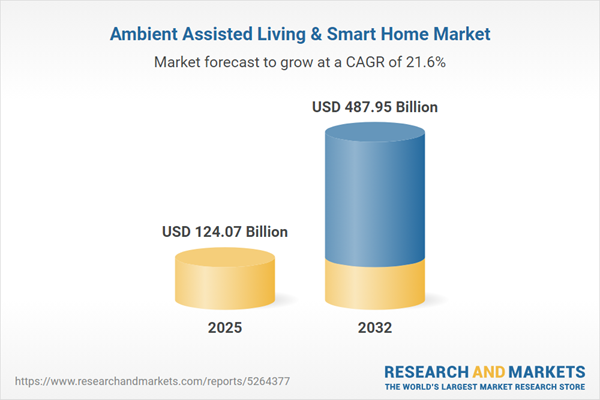Speak directly to the analyst to clarify any post sales queries you may have.
The ambient assisted living and smart home market is changing rapidly as technology, demographic shifts, and healthcare needs converge. This transformation is unlocking new value for providers, payers, and technology vendors aiming to deliver innovative, integrated care solutions to diverse populations.
Market Snapshot: Ambient Assisted Living & Smart Home Market
The Ambient Assisted Living & Smart Home Market grew from USD 102.38 billion in 2024 to USD 124.07 billion in 2025. It is expected to continue growing at a CAGR of 21.55%, reaching USD 487.95 billion by 2032.
Scope & Segmentation
- Product Types: Communication Devices (Intercom Systems, Voice Assistants), Emergency Response Systems, Home Automation Systems, and Wearable Devices (Fitness Bands, Medical Alert Devices).
- Connectivity Options: Bluetooth, Cellular (4G, 5G), Wi-Fi, Z-Wave, Zigbee.
- Applications: Energy Management, Entertainment, Health Monitoring, Safety and Security.
- Distribution Channels: Offline and Online platforms.
- Regions & Key Countries: Americas (United States, Canada, Mexico, Brazil, Argentina, Chile, Colombia, Peru), Europe, Middle East & Africa (United Kingdom, Germany, France, Russia, Italy, Spain, Netherlands, Sweden, Poland, Switzerland, United Arab Emirates, Saudi Arabia, Qatar, Turkey, Israel, South Africa, Nigeria, Egypt, Kenya), Asia-Pacific (China, India, Japan, Australia, South Korea, Indonesia, Thailand, Malaysia, Singapore, Taiwan).
- Major Companies: Amazon.com, Inc., Alphabet Inc., Samsung Electronics Co., Ltd., Apple Inc., Xiaomi Corporation, Honeywell International Inc., Robert Bosch GmbH, Johnson Controls International plc, Schneider Electric SE, Wipro Limited.
Key Takeaways
- Growing adoption is shaped by the convergence of IoT connectivity, cloud-enabled analytics, and an aging global population seeking safety and autonomy at home.
- Interoperability and privacy-by-design have become essential factors in new product development, with platform openness enabling broad integration across diverse care solutions.
- Regulatory complexity is intensifying, especially in regions emphasizing data protection and device safety, compelling vendors to invest in compliance and continuous architectural upgrades.
- Outcome-based service models are rising, where vendors, care teams, and insurers prioritize solutions that provide measurable improvements in resident well-being and reduced health system strain.
- Channel dynamics are evolving; offline channels still drive value with installation and service support, while online channels appeal to tech-savvy demographics prioritizing seamless onboarding and flexible subscription models.
- Product modularity and supply chain diversification help companies maintain resilience amid economic shifts and changing tariffs.
Tariff Impact
Recent tariff adjustments in the United States are prompting the industry to redesign supply chains and reevaluate sourcing strategies. Manufacturers are exploring localized production and swapping out components to minimize vulnerabilities, while procurement teams boost inventory resilience. This shift is reinforcing the importance of total-cost transparency and adaptable product designs that meet buyer and channel partner expectations in fluctuating policy environments.
Methodology & Data Sources
This report integrates primary interviews with industry stakeholders, technical literature reviews, regulatory analysis, and comparative assessments of product capabilities. The mixed-methods research approach ensures insights reflect real-world deployment challenges, regulatory shifts, and evolving commercial models faced by decision-makers.
Why This Report Matters
- Enables senior leaders to benchmark strategic plans against competitor moves and global regulatory changes.
- Supports investment and partnership prioritization by highlighting high-growth segments and optimal regional approaches.
- Delivers actionable segmentation and technology perspectives relevant for product planning, supply chain management, and go-to-market execution.
Conclusion
Sustainable growth in ambient assisted living and smart home markets depends on prioritizing interoperability, measurable care outcomes, and supply chain resilience. Decisions anchored in robust regional and segment insights will position organizations as essential partners within evolving healthcare and consumer ecosystems.
Additional Product Information:
- Purchase of this report includes 1 year online access with quarterly updates.
- This report can be updated on request. Please contact our Customer Experience team using the Ask a Question widget on our website.
Table of Contents
3. Executive Summary
4. Market Overview
7. Cumulative Impact of Artificial Intelligence 2025
Companies Mentioned
The companies profiled in this Ambient Assisted Living & Smart Home market report include:- Amazon.com, Inc.
- Alphabet Inc.
- Samsung Electronics Co., Ltd.
- Apple Inc.
- Xiaomi Corporation
- Honeywell International Inc.
- Robert Bosch GmbH
- Johnson Controls International plc
- Schneider Electric SE
- Wipro Limited
Table Information
| Report Attribute | Details |
|---|---|
| No. of Pages | 180 |
| Published | November 2025 |
| Forecast Period | 2025 - 2032 |
| Estimated Market Value ( USD | $ 124.07 Billion |
| Forecasted Market Value ( USD | $ 487.95 Billion |
| Compound Annual Growth Rate | 21.5% |
| Regions Covered | Global |
| No. of Companies Mentioned | 11 |









